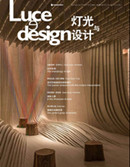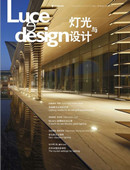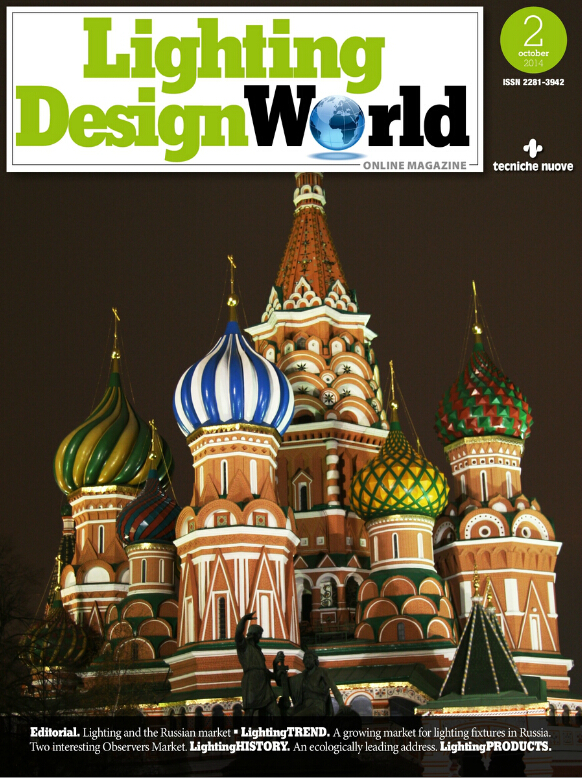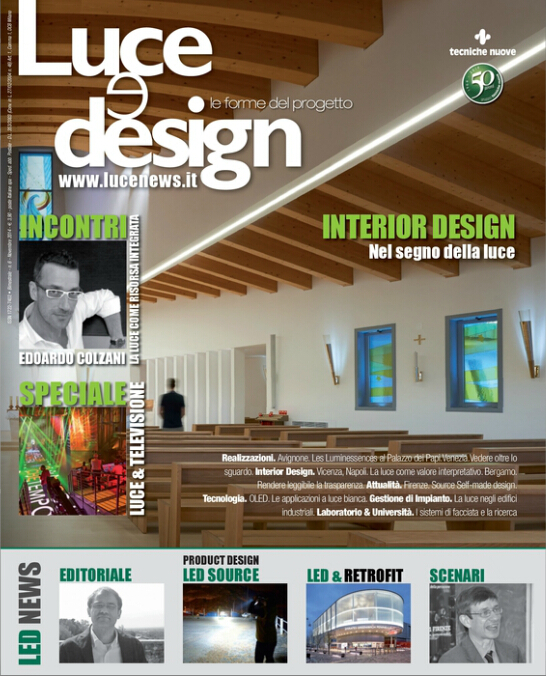文:洛伦佐·高利内莉,奥尔波特·里奇·佩蒂托尼
by Lorenza Golinelli and Alberto Ricci Petitoni
除了达到一定程度的节能要求之外,圣马力诺共和国公共服务司(AASS)想通过公共照明来突出都市环境的历史沉淀和艺术传统,同时优化管理成本.
The enhancement of the artistic and historical heritage of this San Marino village through lighting systems, along with a need to keep costs minimal and improve energy efficiency, were the main driving forces behind this pilot project implemented by San Marino’s independent state-controlled public service company (AASS)
图1:蒙泰吉阿迪诺古镇入口外貌
Picture 1: Entrance to the medieval village of Montegiardino.
圣马力诺共和国的蒙泰吉阿迪诺古镇是该国九个城堡之一。古镇的街景照明工程设计任务委托给了 I-DEA 工程公司。该公司建议采用 LED 新技术,最终使得照明设施更节能,性能更好。
小镇建于古城堡的遗迹之中,以曲径通幽的小巷和古老的石头旧宅为特征,每一块砖头都承载着几个世纪的印记(图1)。由于近来的修复工作,使得这些建筑作为古迹很好地保留了历史特征,其中突出的是半圆形的城堡大门,城门上雕刻着古镇的城徽——在三座山峰顶上的植物丛中长着三种鲜花;1865年为供奉圣劳伦佐而建造的教区教堂和钟楼以及用石头花砖铺设的十字架之路,这一切构成了很有特色的风景。
图2:古镇入口处三条拱廊之一
Picture 2: Custom-made Corten steel torch fitted with an amber LED spotlight to light up the entrances to the village
图3:采用 Corten 钢定制的火炬状灯壳,内设琥珀色LED射灯,用于古镇入口的照明
Picture 3: Montegiardino. One of the three porticoes accessing the village
照明工程的理念
此项工程的目的是以节能和减少散射光为原则,利用灯光重新营造历史环境。换句话说,就是以艺术的形式来使用灯光,使其表达出古镇的内涵,进而创造出有本地特点的环境的氛围。
照明工程的设计理念源自几个主要的考虑:实施场景照明,在城堡的入口处安装定制的琥珀色灯光的火炬灯,突现历史旧貌(图2、3);间或设置暖色的白炽灯,烘托环境细节,突出表现小巷的曲径幽深(图4);通过安装不同色调的 LED 射灯实现对教堂和钟楼的建筑照明(图6、7);对街道和走道实施正确的功能照明,以便尽可能限制耀眼的灯光(图8),特别强调保留历史要素的原汁原味。
对于古镇那样的具有历史环境价值地区的照明应当给人舒适愉快的感觉,即使深晚漫步街上,仍然沉浸在私密亲昵的气氛之中。
图4:采用 LED 灯的古镇小巷的照明
Picture 4: Montegiardino. LED lamps illuminating the alleyways of the village
由于使用了光学性能最好的 LED 射灯,因此获得了显著的效果:尽管射灯数量翻了一番,确仍然相当节能,用电量几乎减少了一半,每年节电大约25.000 kWh,借助于照明反差和反射,以较低的能耗凸显了对古迹的照明。
此外,通过利用不同色调和亮度的灯光,重新实现对古镇的开发,用琥珀色灯光凸显古镇入口的历史风貌,用暖色白炽灯光(4200 K)彰显人行小巷的幽深宁静,并用彩色灯光照射十字架之路的石头花砖(图5)和古镇内的喷泉,再现出中世纪古镇恬静祥和的氛围。
另一个显著的特点是重新利用印有圣马力诺共和国国徽的传统灯笼,更换电线,配上温度超过4200 K的发出暖色白炽灯光的平板LED。根据最新的意大利和欧洲的法律规定,减少了光污染,更换了陈旧的电气装置,提高了系统的安全性和适应性。
图5:十字架之路石头花砖的照明
Picture 5: The flagstones of Via Crucis illuminated
The task of lighting up the medieval village of Montegiardino, Republic of San Marino, was commissioned by the engineering firm I-DEA. To ensure the lighting system would provide optimal savings and enhanced performance, the firm proposed using new LED technology. The medieval village of Montegiardino is one of San Marino’s nine Communes or “Castelli”.
The village, built upon the ruins of the ancient Commune, is characterised by its winding streets and ancient stone houses, which every brick is imbibed in history (picture 1). Following recent restoration works, these buildings now form part of a carefully preserved and unique historic monument. Highlights of the village include the rounded door to the Commune displaying the village’s coat of arms with its three-flowered plant atop three hills, the parish church and bell tower of San Lorenzo (built in 1865), as well as the flagstones of Via Crucis.
图6:圣劳伦佐教堂和广场的照明方案一例
Picture 6: Montegiardino. Studio mock-up of the lighting idea proposed for the Square and Church of San Lorenzo
The technical lighting model
The focus of the project was to use lighting to recreate a historic feel with an emphasis on improving energy efficiency and reducing diffuse reflection. The aim was to use lighting artistically as a form of expression: the place and its atmosphere are designed, created and shaped.
The following key considerations formed the basis of the technical lighting model: to illuminate the scenery using custom-made, amber-glow medieval torches to light up the Commune’s entry points (pictures 2, 3); to light up the streets and bring their unique atmosphere to life using warm, white lighting tones, (picture 4); to install various shades of LED spotlights to illuminate the church and its bell tower (pictures 6, 7); to light up the alleyways and streets and at the same time reducing glare, particularly of the historic monuments, as much as possible (picture 8).
The illumination of this historical village has made it a welcoming and pleasant place to stroll around, even at night, and has instilled it with an atmosphere of both safety and intimacy.
Through the use of LED spotlights and high-performance lighting, the main objective was achieved: namely the reduction of energy consumption. Despite the fact that the number of spotlights has doubled, consumption has almost halved, giving annual savings of approximately 25,000 kWh thanks to the use of low-consumption contrast lighting and their reflections to light up the monuments.
图7:圣劳伦佐教堂一瞥
Picture 7: The Church of San Lorenzo
Various lighting tones and intensities were used in the medieval village: amber light was used to illuminate the entrances to the ancient village; warm, white tones (4,200 K colour temperature) were used for the alleyways; and coloured lights were used to illuminate the flagstones of Via Crucis (see picture 5) and the fountains.
Another important feature is the restoration of ancient torches bearing the Republic of San Marino’s coat of arms. They have been rewired with LED plates to give off a warm, white light (4,200 K). In line with current Italian and European legislation, light pollution has been reduced, and, in order to improve the system’s safety and allow it greater flexibility, the obsolete electrical components of the lighting system have been replaced.
图8:古镇入口处街道一瞥
Picture 8: Montegiardino. Another entrance-point to the village
项目信息
项目名称 Project Name:
古镇蒙泰吉阿迪诺,圣马力诺Montegiardino, Republic of San Marino
客户Client:
AASS – 圣马力诺共和国公共服务司 Azienda Autonoma di Stato per i Servizi Pubblici della Repubblica di San Marino
设计和监理 Design and management team:
I-Dea 公司 (建筑师洛伦佐•高利内莉,工程师 奥尔波特•里奇•佩蒂托尼)–伊莫拉(波伦亚省) I -Dea Srl (architect – Lorenza Golinelli, engineer – Alberto Ricci Petitoni) – Imola (Bologna)
照明设备供应商: Litek, Modus: 灯笼及 CDM 灯泡和 LED 板; DGA (设计师. Scuba, Sirio, Giove):十字架之路的灯光照明;圣劳伦佐教堂和小巷建筑细部的灯光照明; Philips Lighting (设计师 Graze Powercore, LED灯带, LED水下灯, LED泛光灯, LED投光灯), 圣劳伦佐教堂和钟楼的建筑照明和古镇细部的照明; Ghidini Illuminazione
Lighting system suppliers: Litek, Modus: torches with CDM bulbs and LED plates; DGA (models – Scuba, Sirio, Giove): illumination of Via Crucis, Church of San Lorenzo and the architectural features of the alleyways; Philips Lighting (models – Graze Powercore, LEDLine, Underwater, LEDflood, Beamer LED): illumination of Church of San Lorenzo and its bell tower as well as the architectural features of the village; Ghidini Illuminazione
灯光设计师与客户
项目历程
我们想了解一下设计过程和客户与照明设计师以及照明设计师与建筑师之间的关系。虽然做决定的时候都很困难,但是最终设计成品的质量正是取决于这些关系。
你在哪个设计阶段与客户接触?你是直接还是通过项目建筑师与客户接触?
项目一开始的时候客户就立即与我们取的了联系。照明设计部分实际上是这个古镇重建项目的出发点。这也是推动古镇重建计划的驱动力,城堡委员会从几年前直至今日一直致力于此。
你们有关照明工程的所有方案选择都得到了客户的确认码?
设计方案提出之后经过居民公开讨论,获得了客户、古镇居民和蒙泰吉阿迪诺城堡委员会一致认可和共享。从最初构思一直到方案实施,作了各种不同的试验包括夜间局部地区的照明实验,验证了方案中场景照明的效果,从而更好地解决了项目的实施问题。
你们与照明设备供应商的关系如何?
我们与照明设备供应商的合作关系一直很好、很稳定,他们提供我们若干个样品供夜间试验,与我们联合开发了许多定制的设计方案,譬如开发设计了采用 Corten 钢(低合金高强度耐蚀钢)定制的火炬状灯具,在传统灯笼内配装 LED 板,灯笼外面安装圣马力诺共和国国徽。所有这一切都是为了从项目构思一直到整个项目乃至每一个小细节都能顺利进行,圆满实施,包括所有灯具和电源线的设置路线和安装。
Lorenza Golinelli (left) and Alberto Ricci Petitoni (right)
The Lighting Designer & Client
THE PROJECT ITINERARY
We were intrigued to hear about the project itinerary and get an understanding of the relationships between the lighting designer and the client and the lighting designer and the architect. Although the decision-making process was not always easy, the creation of a high-quality final design rested on the strength of these relationships.
At what stage of the design process did the client contact you? Did you have direct contact with the client or did you liaise through the architect?
The client contacted us straight away. The lighting design was the starting point of the project to restore the village, or rather it was the driving force behind helping to complete the restoration work that the Municipality had been working on over many years.
With regards to the lighting design, were all of your ideas accepted by the client?
The design decisions were made by the client, the Municipality of the Castello di Montegiardino and its residents. The design was presented to and discussed with the residents. A number of night time tests were carried out throughout the process, from the initial idea to the final design, to review the proposed lighting effect in-situ, which enabled a greater definition of the final design.
How strong was your relationship with the lighting suppliers?
Our relationship with the lighting suppliers was highly collaborative and reliable. They supplied us with various samples for night time testing and collaborated in the development of a number of designs such as the design of a custom-made Corten steel torch and the fitting of LED plates into traditional lanterns bearing the Republic of San Marino’s coat of arms. This helped ease the process from the initial design stage to completion down to the smallest details, which included the layout and installation of the entire lighting system and its energy supply.
照片提供: 奥尔波特•里奇•佩蒂托尼
All photo courtesy: Alberto Ricci Petitoni










































